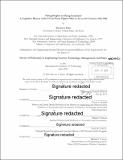Flying knights or Flying scientists? a cognitive history of the US Air Force Fighter Pilot in air-to-air combat, 1950-1980
Author(s)
Fino, Steven A. (Steven Andrew)
DownloadFull printable version (41.59Mb)
Alternative title
Cognitive history of the US Air Force Fighter Pilot in air-to-air combat, 1950-1980
Other Contributors
Massachusetts Institute of Technology. Engineering Systems Division.
Advisor
David A. Mindell.
Terms of use
Metadata
Show full item recordAbstract
US Air Force fighter aircraft underwent a remarkable transformation in the period from 1950 to 1980. Whereas the lone fighter pilots of earlier fame relied on the power of their eyesight, the finesse of their piloting skills, and a steady squeeze of the trigger to achieve victory, later pilots vanquished their foe by focusing on a four-inch-square cockpit display, manipulating electromagnetic waves, and launching rocket-propelled missiles from miles away. Two popular historical narratives dominate this period in fighter aviation: one of "great machines," which focuses on the technologies; the other of "great pilots," which focuses on the oft-heroic aviators. The former conjures notions of technological determinism; the latter, a timeless "myth of the fighter pilot." Regrettably, the two distinct approaches obscure the important human-machine interactions that linked the pilots with their fire control technologies. This study presents an alternative perspective of fighter aviation, viewing it instead as an inseparable system of humans and machines working together. I develop a cognitive history of the air-to-air fighter pilot, analyzing three sequential experiences: the F-86E Sabre during the Korean War, the F-4C Phantom II during the Vietnam War, and the F-15A Eagle during a pair of air combat evaluations conducted in 1977. In each case, new fire control systems were introduced to simplify weapons employment and thereby free the pilot to focus attention on other tasks deemed more vital, such as flying itself. The pilots, however, soon realized that within air combat, their traditional flying skills were becoming less critical to their success and survival; in contrast, the skills required to operate their new fire control systems were growing in significance and complexity. With the pilots uniquely vested in sustaining the "fighter pilot myth," tension and conflict ensued, both within individual fighter cockpits and in the social relationships that extended between fighter cockpits. This study offers fresh insight into issues of technological change that confront today's military aviators, especially regarding remotely piloted aircraft. More generally, this study addresses the tensions that often arise when increasing automation alters or displaces the tasks that have historically defined an individual's profession.
Description
Thesis: Ph. D. in Technology, Management, and Policy, Massachusetts Institute of Technology, Engineering Systems Division, 2014. Cataloged from PDF version of thesis. Includes bibliographical references (pages 419-464).
Date issued
2014Department
Massachusetts Institute of Technology. Engineering Systems DivisionPublisher
Massachusetts Institute of Technology
Keywords
Engineering Systems Division.